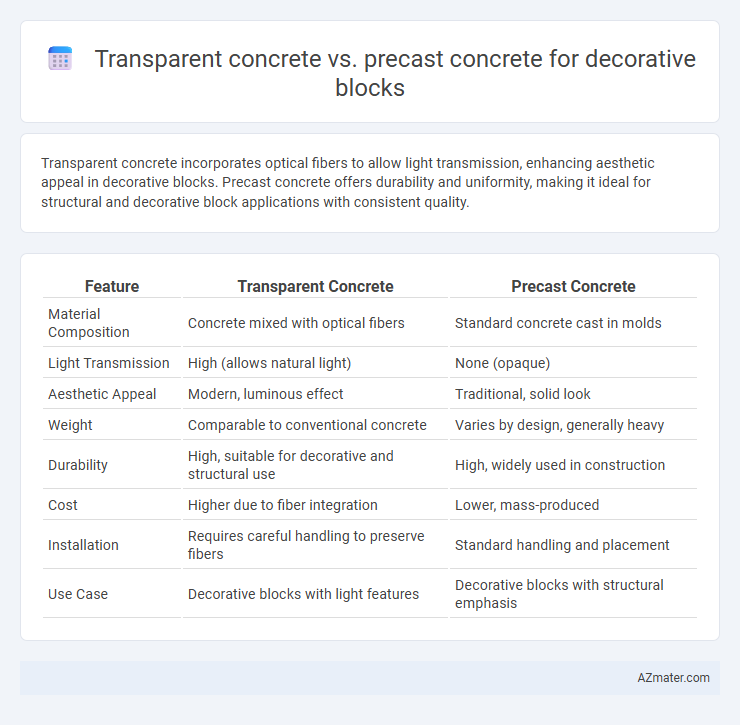Transparent concrete incorporates optical fibers to allow light transmission, enhancing aesthetic appeal in decorative blocks. Precast concrete offers durability and uniformity, making it ideal for structural and decorative block applications with consistent quality.
Table of Comparison
| Feature | Transparent Concrete | Precast Concrete |
|---|---|---|
| Material Composition | Concrete mixed with optical fibers | Standard concrete cast in molds |
| Light Transmission | High (allows natural light) | None (opaque) |
| Aesthetic Appeal | Modern, luminous effect | Traditional, solid look |
| Weight | Comparable to conventional concrete | Varies by design, generally heavy |
| Durability | High, suitable for decorative and structural use | High, widely used in construction |
| Cost | Higher due to fiber integration | Lower, mass-produced |
| Installation | Requires careful handling to preserve fibers | Standard handling and placement |
| Use Case | Decorative blocks with light features | Decorative blocks with structural emphasis |
Introduction to Transparent and Precast Concrete
Transparent concrete incorporates optical fibers or resin-based materials to allow light transmission while maintaining structural integrity, making it ideal for innovative decorative blocks that enhance aesthetic appeal with natural light diffusion. Precast concrete consists of factory-cast, high-strength components that offer precise dimensions and durability, widely used in decorative blocks for uniformity and efficient installation. Both materials serve distinct functional and design purposes in modern construction, with transparent concrete prioritizing light permeability and precast concrete emphasizing structural performance and versatility.
Defining Transparent Concrete: Key Features
Transparent concrete, also known as light-transmitting concrete, incorporates optical fibers or light-permeable elements to allow natural light to pass through while maintaining structural integrity. Key features include high translucency, enhanced aesthetic appeal, and energy efficiency due to daylight utilization. Unlike precast concrete decorative blocks, which prioritize uniformity and strength, transparent concrete emphasizes visual effects and innovative lighting applications.
What is Precast Concrete? Essential Characteristics
Precast concrete is a construction material manufactured by casting concrete in reusable molds at a controlled factory environment before transporting it to the construction site. Its essential characteristics include high strength, durability, precise dimensional control, and improved quality due to standardized production processes. Precast concrete decorative blocks offer consistency in appearance and structural integrity, making them ideal for architectural applications where uniformity and reliability are critical.
Aesthetic Differences: Visual Appeal and Design Flexibility
Transparent concrete offers unique aesthetic value through its light-transmitting properties, creating luminous surfaces that enhance architectural designs with natural illumination and shadow play. Precast concrete decorative blocks provide versatile design flexibility with customizable textures, colors, and shapes, enabling intricate patterns and consistent finishes for various stylistic themes. While transparent concrete emphasizes innovative light effects and modern aesthetics, precast concrete excels in adaptability and detailed decorative options suitable for a wide range of architectural applications.
Light Transmission: Functional and Decorative Impacts
Transparent concrete offers superior light transmission compared to traditional precast concrete, allowing natural or artificial light to pass through embedded optical fibers, enhancing both functional illumination and aesthetic appeal in decorative blocks. This property enables the creation of dynamic and visually striking architectural elements that reduce the need for artificial lighting during daytime. Precast concrete, while structurally robust and versatile in design, lacks this inherent translucency, limiting its capacity to contribute to interior light diffusion and unique decorative effects.
Installation Processes: Methods and Timeframes
Transparent concrete installation for decorative blocks involves embedding optical fibers within a cement matrix, requiring precise alignment and careful curing to maintain light transmission, typically extending the installation timeframe by 20-30% compared to traditional methods. Precast concrete decorative blocks are manufactured off-site under controlled conditions, allowing for faster on-site installation through modular assembly, reducing overall construction time by up to 40%. The installation methods for transparent concrete demand specialized labor and meticulous handling, while precast blocks benefit from streamlined processes and standardized dimensions, affecting project timelines significantly.
Durability and Structural Performance Comparison
Transparent concrete exhibits superior light transmission, enhancing aesthetic appeal without compromising durability, making it suitable for decorative blocks requiring both strength and visual impact. Precast concrete offers high structural performance due to controlled manufacturing conditions, ensuring consistent compressive strength and durability, especially in load-bearing applications. While transparent concrete provides moderate structural capacity, precast concrete remains the preferred choice for long-term durability and high load resistance in decorative block installations.
Cost Analysis: Budget Considerations
Transparent concrete typically incurs higher material and production costs compared to precast concrete due to the integration of light-transmitting elements such as optical fibers or resin-based components. Precast concrete decorative blocks offer a more cost-effective solution with standardized manufacturing processes that reduce labor and installation expenses. Budget considerations must account for long-term benefits, where transparent concrete may justify its premium through enhanced aesthetic appeal and natural lighting advantages.
Sustainability and Environmental Benefits
Transparent concrete incorporates optical fibers, allowing natural light to pass through, significantly reducing the need for artificial lighting and lowering energy consumption. Precast concrete blocks offer durability and efficient manufacturing with reduced material waste and energy use compared to in-situ concrete production. Both materials contribute to sustainability, but transparent concrete enhances daylighting and reduces lighting energy demand, while precast concrete optimizes resource use through controlled fabrication and minimized onsite waste.
Ideal Applications: Choosing the Right Concrete for Decorative Blocks
Transparent concrete, embedded with optical fibers, allows light transmission, making it ideal for decorative blocks in architectural features such as facades, partitions, and artistic installations where aesthetic appeal and natural light integration are priorities. Precast concrete offers versatility, durability, and cost-efficiency, making it suitable for structural decorative blocks in building exteriors, landscaping, and modular construction that demand consistent quality and quick installation. Selecting the right concrete depends on balancing design intent, light requirements, and structural performance to achieve desired visual impact and functional benefits.

Infographic: Transparent concrete vs Precast concrete for Decorative block
 azmater.com
azmater.com